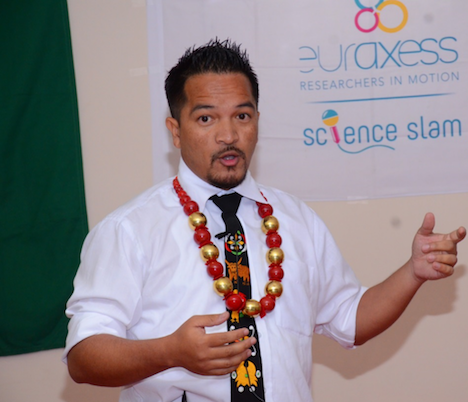
Whether you are studying, teaching or doing science, talking about it in plain English seems to be a daunting, and universal challenge. Wouldn’t you agree? Sooner or later, a lot of us succumb to ‘expert speak’, where the description of your research gets peppered with technical and field-specific jargon. It’s easy to talk to others in the same field (or taking the same class); but talk to anyone other than that, and you are likely to get a glazed look and intense struggle to not ‘look bored’. If you are someone passionate about doing science, how do you inspire the same passion and enthusiasm for science in your audience? Try out your communication skills and apply to EURAXESS Science Slam India 2017 — entries to the competition can be submitted till October 10th.
Now in its fifth year, the EURAXESS Science Slam India aims to encourage trainees to talk about their research to a non-expert audience; and to do so in a fun and entertaining way. This year, the scope of entries is widened to include Masters’ students, in addition to PhD students and Postdocs in years past. Trainees from all fields including Social Sciences and Humanities, Life Sciences and Engineering are eligible to apply.
Damanbha Lyngdoh, who was crowned the Science Slammer in 2016, is a PhD student in Parasitology at North-Eastern Hill University, Shillong. He also teaches in the Zoology Department at St. Anthony’s College. “Fieldwork for my Dissertation research takes me to all states in the North-East. There is incredible cultural diversity in this part of the country. There are 26 major tribes in Arunachal Pradesh alone, 23 in Nagaland, and so on.. I need to be able to communicate with them in ways that are sensitive to their customs. Sometimes people are not literate; which presents an added challenge. Considering all this, honing my abilities in communicating science is a top priority; as much as doing (and teaching) science is. And I had been looking for channels that would help me do just that. Browsing through YouTube on one occasion, I came upon slam competition entries. In German! So I looked around to see if there was something like that in India too…and sure enough…”
“Most of the audience in Bangalore at the communication training workshop were from science background. And yet my attempt to communicate my work didn’t go as well as it could have been. I realised that you can’t assume that people are from science background, so they know ‘your science’. Every opportunity to communicate your science to a new audience is a new challenge. You need to tailor your message accordingly”, said Lyngdoh.
Other finalists echoed the value of taking the audience-centric approach to communicating science. Ananth Krishna, also one of the finalists, shared how while planning and conducting research, the focus is on the scientist doing the study — what you want to test/what are you looking to find, etc. But when presenting the same research to other people, it is the audience that matters. “It is not easy to bring about this shift in your own mindset. Mostly, we discuss with people in similar field/area of interest, which only fosters the use of technical jargon. That’s why sharing your research with a diverse audience can be immensely powerful.”
Arnab Bhattacharya (faculty from TIFR Bombay), who conducts the science communication training of finalists, strongly believes it is imperative to interact with other fields, whether you are studying science, teaching it or practicing it.
Interaction with people from different fields, that is one of the perks of participating in the science communication training ground called Science Slam. More details on this year’s competition can be found at EURAXESS Science Slam India website. Go on…slam your way to Europe.
